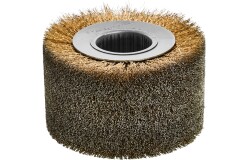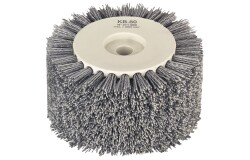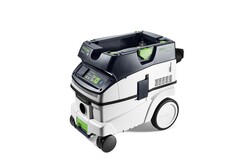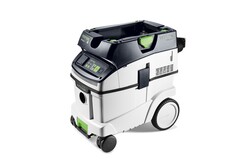Adding texture to wood by brushing it wiith "Rustofix"

Description
Brushed wooden surfaces are required for producing rustic furniture or for decorating the interior of rustic restaurants (wall and ceiling panelling), for example. Wooden beams can also be brushed and processed in this way.

Tools/accessories
Alternative tools
Preparation/set-up
-
Always use the LD 85 rustilon brush with steel wire for texturing.

-
Set the required texture depth using the rear thumbwheel.

-
If you are texturing planks, then you should use support planks to extend the plank surfaces of the workpiece at the front ...

-
..and at the rear to support the rollers. This ensures that the Rustofix glides evenly across the surface of the workpiece. This stops the tool from plunging into the workpiece surface when brushing wood.

Procedure
-
Always guide the RUSTOFIX in the direction of the wood grain.
Work the surface evenly.
-
This figure shows a textured surface compared to a smooth surface.

- Once you have created the texture you require, change brushes. Now fit the KB 85 rustilon brush with plastic bristles (Please follow the instructions in the operating manual).
When you first use the steel wire brush, the wood surface will become very raw due to protruding wood fibres. In the second working procedure, plastic bristles sand the textured surface to lend a smooth finish. Then you can carry out your required surface treatment.
- This figure shows the surface after it has been sanded with the plastic bristles of the KB 85 rustilon brush.
Note:- Do not use the plastic bristles to texture wood. Brushing wears these down more quickly and it takes considerably longer to create a textured finish.
- The BG 85 brush with sisal bristles for smoothing and removing salt residues, for example, after staining is offered as one of the system accessories for RUSTOFIX

-
Our illustrated guides and work results are documented working steps that we have performed in practice. They are individual examples and do not guarantee or promise that users will obtain the same results. The results will depend on the user's experience and skill, as well as the material being used. Illustrated guides do not replace any Festool operating manuals and/or safety instructions. Liability for ensuring that the information, instructions and applications are free from content defects and defects of title, in particular with regard to the absence of defects, correctness, freedom from third party intellectual property rights and copyrights, completeness and fitness for purpose, is excluded. Claims for damages made by the user, regardless of their legal basis, are excluded. These liability exclusions are not applicable if the damage was intentional or caused by gross negligence, or in cases of statutory liability.
We cannot accept liability for damage resulting from defects.↑












































